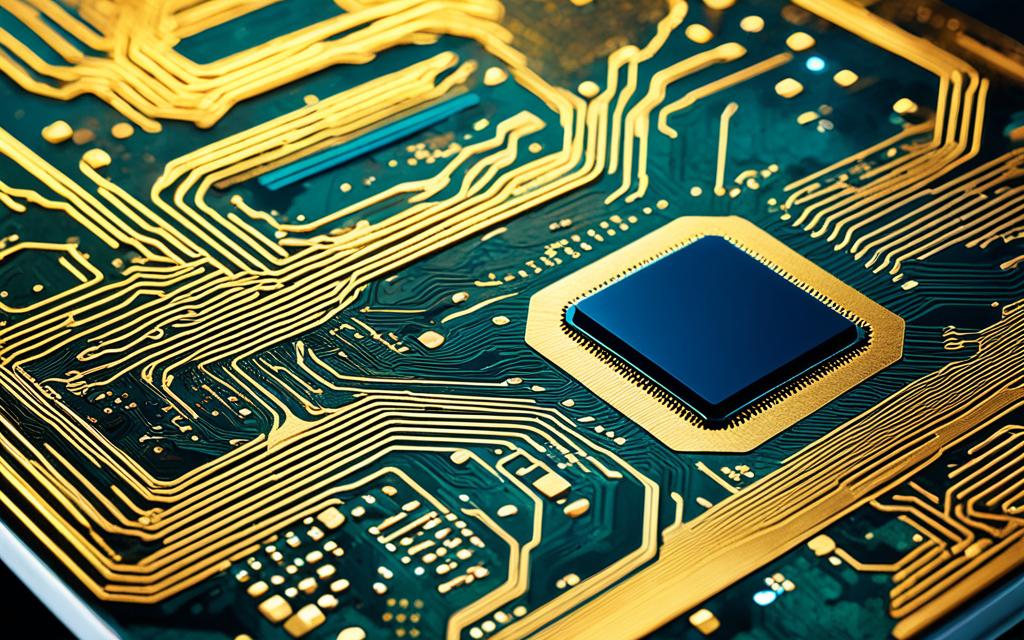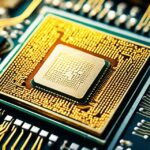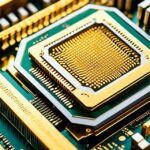Table of Contents
Gold in Central Processing Units (CPUs) does more than just make them look good. It is crucial for the performance and reliability of our electronic gadgets. Exploring gold recovery from electronics shows us a way to tackle the problem of electronic waste. Most desktop CPUs have about 0.25 to 0.5 grams of gold. But, older ones can have up to 2 grams1. Also, getting gold out of thrown-away tech can lead to finding lots of valuable bits2.
Considering how many CPUs are used worldwide, the total gold they contain is quite a lot3. This shows the economic benefits and environmental importance of recycling CPUs properly.
Key Takeaways
- The gold content in CPUs varies by age and type, with older models typically containing more.
- Gold is integral for its conductivity and corrosion resistance in electronicuri devices.
- Recovering gold from e-waste presents economic opportunities and promotes sustainability.
- Specialised processes are required for efficient gold recovery from CPUs.
- The extraction potential from CPUs is significant, given the vast number of devices globally.
- Market prices for gold heavily influence the feasibility of recovery operations.
Introduction to Gold in Electronics
Gold is key in electronics, boosting reliability and performance of key parts. Its unmatched conductivity, resistance to tarnish, and thermal stability make it a top choice for making electronic parts. In CPUs, we often find gold in soldered connections, plated connectors, and integrated circuits. This shows its role in gold electronics.
The Role of Gold in Modern Technology
Gold’s value in technology is huge. As gadgets get more advanced, the demand for top-quality materials rises. For example, a ton of electronic waste from computers has more gold than 17 tons of gold ore4. This fact underlines gold’s worth in electronics and the chance for the recycling electronics sector.
Importance of Gold Recovery from Electronic Waste
Getting gold back from electronic waste has become very important in e-waste management. With loads of outdated computers around, recovering gold from them has both environmental and economic upsides. In the US, gold retrieved from electronic junk in 1998 matched the output from over 2 million tons of gold ore and waste4. As we grow more aware of bad disposal methods, skilled recyclers play a crucial part in using resources well and reducing environmental harm.
Since valuable metals like gold are in various parts, like circuit boards and connectors5, effective recycling electronics programmes have become key for sustainability. The major environmental harm from wrong disposal highlights the need for good practices in gold recovery electronic waste. It promotes a more thoughtful way of handling tech.
How Much Gold in a CPU
Gold has played a vital role in CPUs over the years. Its use peaked in vintage CPUs for their conductive benefits, especially in the 1960s and 1970s military and aerospace sectors. The shift to cost-saving options reduced gold in modern processors, marking a clear gold content evolution.
Historical Context of Gold Use in CPUs
Older CPUs from Intel and Motorola are sought after for gold recovery, offering more gold. The Pentium Pro stands out with about 1 gram of gold, worth around $46.306. Nowadays, CPUs like the Intel Celeron have less gold, showing a move to cheaper materials to cut costs7.
Factors Influencing Gold Content in Different CPU Models
The gold in CPUs varies greatly due to factors like age, function, and design. Older, ceramic-pack CPUs often have more gold. For example, the IBM 5x86C has about 0.1g of gold in its 20.65g weight7. Meanwhile, the AMD K5 in the high yield group contains roughly 0.5g of gold, worth $23.156.
The type of packaging, gold plating thickness, and manufacturing era all affect gold content. Though top CPUs can hold 0.4-0.5 grams of gold, recent models show a trend of reduction, highlighting the industry’s evolving nature8.
Components of a CPU that Contain Gold
Understanding the CPU components that hold gold is crucial for effective electronics recycling. Gold is used in CPUs for better performance and durability because of its conductivity and corrosion resistance. CPUs with gold parts are very valuable.
Integrated Circuit Packaging and Gold Components
Modern computing relies heavily on integrated circuits. These circuits have gold parts such as:
- Gold-plated caps
- Leads
- Bonding wires
- Contact pads
In the past, gold-rich processors used solid gold wire bonds. Now, with new materials, these are less common. This explains why some CPUs are more valuable due to their gold content.
Types of CPUs with Higher Gold Content
Some CPUs stand out for their high gold content. For example, the Intel 386 and 486 CPUs have a lot of gold in their pins. This makes them highly sought after by recyclers9. The Intel Pentium Pro Processor is also prized for its gold, containing about 0.33 grams per unit9. However, CPUs made after 1998 have less gold, as manufacturing changed9.
The drop in gold in newer CPUs is important for recyclers. Here’s a table with some CPU models and their gold content:
| CPU Model | Gold Content (grams) | Approx. Value (USD) |
|---|---|---|
| Intel 386 | 0.25 – 0.35 | $8 – $12 |
| Intel 486 | 0.25 – 0.5 | $8 – $15 |
| Intel Pentium Pro | 0.33 | $10 – $20 |
| Modern CPUs | 0.05 – 0.2 | $2 – $6 |
There’s a big difference in gold content between older and newer CPUs. It shows why it’s good to focus on certain models when recycling electronics.
The way the electronics industry values gold in CPU components is changing. This sparks interest in recycling gold-rich processors effectively1011.
Gold Extraction: Why It’s Not Always Profitable
Getting gold from CPUs looks good on paper but is tough in reality. Working with dangerous stuff like hydrochloric and nitric acid is risky. It might harm your health, and often, you won’t make any money. If you don’t have lots of e-waste, you’ll spend more than you earn. Say, a computer might have gold worth over $10, but getting it is hard. So, trying to get gold on your own is full of hurdles12
Challenges in DIY Gold Recovery from CPUs
For those not skilled, pulling gold from CPUs is tricky. You need special gear and lots of knowledge. It often takes at least two pounds of gold to cover the recycling costs. This makes it tough to make money from just a little bit of gold13. Also, many don’t know how much gold there is in parts, with some having 40 to 800 times more gold than a metric ton of ore14. So, many don’t recycle efficiently because they miss these facts.
Professional Recycling: How It Works
Using expert gold recycling services is a smart move for gold recovery. They have efficient recycling processes that get more gold out, starting with collecting old gadgets. They take apart electronics carefully to get to the gold parts. Then, they melt it down to get the gold. This way, they make the most out of a lot of e-waste. They also know how to get gold without harming the planet. Their knowledge helps make recycling good for both the environment and the economy.
Conclusion
The value of gold in CPUs is quite interesting, especially when we look at recycling and environmental effects. Computers have a good amount of gold, about 0.1 to 0.15 ounces each. This shows a big chance for recycling in dealing with electronic waste15.
Additionally, getting gold from old computers is economically smart. One ton of computer scrap has more gold than 17 tons of mined gold ore15. Also, with electronic waste growing by 3-5% every year worldwide, reaching 50 million tonnes16, the push for efficient recycling is clear.
It’s vital to encourage people and businesses to think about how they throw away electronic waste. Seeing the value in our old electronics, like memory chips and motherboards, shows why we need to recycle. This discussion on CPU gold underlines the immediate need for better recycling options. These should get back valuable metals and save our earth for the next generations.
To know more about how gold is taken out and reused from computers, check this detailed guide on gold in computers. It gives a thorough look at the recycling possibilities.
FAQ
What is the primary role of gold in CPUs?
Gold plays a key role in CPUs because of its great conductivity and resistance to corrosion. Its thermal stability also keeps connections reliable. This ensures electronics perform well.
Why is gold recovery from electronic waste important?
Recovering gold from e-waste is vital. It fights resource scarcity and tackles environmental harm from e-waste. Through recycling, we can get back valuable metals and encourage green habits.
How much gold can be found in a CPU?
CPUs contain varying amounts of gold, depending on their age and design. Older models, from the 60s and 70s, usually have more gold than newer ones.
Which specific components within a CPU contain gold?
Gold is found in parts like gold-plated caps, leads, and bonding wires. Contacts in integrated circuits also contain gold. These parts are essential for the CPU to work properly.
What types of CPUs are known for having higher gold content?
The Intel 386, Intel 484, and Pentium Pro CPUs have more gold. They were made for durability and top performance, making them good for recycling.
What are the risks associated with DIY gold recovery from CPUs?
DIY gold recovery is risky due to harmful chemicals, like acids. The process is often too costly without enough material, leading to greater expenses.
How do professional recycling services extract gold from CPUs?
Professional recyclers use effective processes to extract gold. They collect, dismantle, and smelt CPUs. This ensures gold recovery is safe and eco-friendly.
What is the environmental impact of improper electronic waste disposal?
Wrong disposal of electronics can harm health and the environment. It fills landfills with dangerous waste. Good recycling practices reduce these risks.
Source Links
- https://softwareg.com.au/blogs/computer-hardware/how-much-gold-can-be-recovered-from-a-cpu – How Much Gold Can Be Recovered From A CPU
- https://softwareg.com.au/blogs/computer-hardware/how-much-gold-in-a-cpu – How Much Gold In A CPU
- https://www.finishing.com/269/90.shtml – How many computers for one ounce of gold?
- https://pubs.usgs.gov/fs/fs060-01/fs060-01.pdf – U.S. Geological Survey Fact Sheet 060-01
- https://www.conceptmanagement.co.uk/knowledge/materials/precious-metal/ – Precious Metal Removal from Electronic Components
- https://www.ozcopper.com/computer-cpu-gold-yields/ – OzCopper | CPU Gold Content
- https://www.scrapmetalforum.com/general-electronics-recycling/7633-list-cpu-chips-gold-content.html – List of CPU Chips / Gold Content
- https://www.goldnscrap.com/post/gold-recovery-process-from-ceramic-cpu-s-part-1 – Gold recovery process from Ceramic CPU’s – Part 1
- https://www.chipsetc.com/gold-value-in-computer-chips.html – Gold value in computer chips
- https://www.products.pcc.eu/en/blog/what-electronics-contain-the-most-gold-recovery-of-noble-metals-from-electronics/ – What electronics contain the most gold? Recovery of noble metals from electronics – PCC Group Product Portal
- https://interestingengineering.com/innovation/how-much-gold-is-in-your-computer-and-how-efficient-it-is-to-reclaim-it – How Much Gold Is in Your Computer and How Efficient It Is to Reclaim It
- https://www.waferworld.com/post/how-is-gold-used-in-computers – How Is Gold Used in Computers?
- https://sdbullion.com/blog/how-much-gold-is-in-a-computer-desktop-laptop – How much Gold is in a Computer Desktop or Laptop?
- https://www.trustcobalt.com/articles/its-not-the-gold-that-makes-your-old-electronics-valuable-so-what-is-it/ – It’s Not the Gold That Makes Your Old Electronics Valuable. So What Is It? – Cobalt | Certified Electronics Recycling
- https://www.americanbullion.com/gold-recovery-from-electronics/ – Gold Recovery from Electronics | American Bullion
- https://pubs.rsc.org/en/content/articlehtml/2020/ra/c9ra07607g – Challenges and opportunities in the recovery of gold from electronic waste












